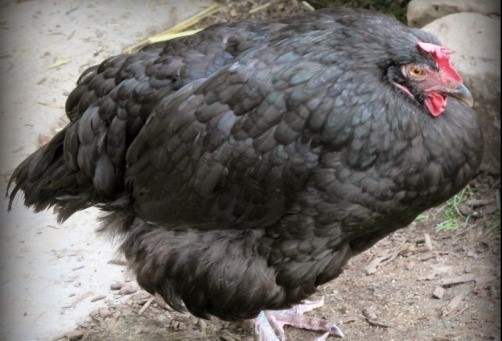IMPORTANT DISEASES IN POULTRY AND THEIR MANAGEMENT
Diarrhoea
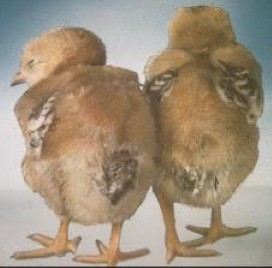 |
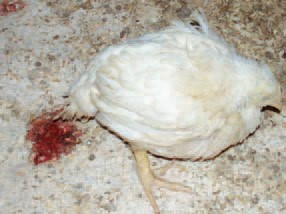 |
| Salmonelosis | Coccidiosis |
Symptoms
- Diarrhoea (also known as scours or dirty vent). The stool or droppings of the chickens are not firm but very loose, watery, not of the normal colour and may contain blood.
• This may cause the feathers of the vent to be soiled and caked together.
• Depression.
• Reluctance to eat, drink and move about.
• Poor growth.
• Death.In dead chickens
• Poor condition.
• The intestines may be red and swollen and the contents watery.
• There may also be a yellow butter-like substance around the heart, liver and intestines.Causes
There are many different types of organisms that can cause diarrhoea, which include:
• Bacteria (Salmonella, E. coli, Pasteurella)
• Viruses (Newcastle disease, gumboro disease)
• Parasites (coccidiosis, worms)
• Fungi (Candida, Aspergillus)
Treatment
- Use an antibiotic (Colistin Sulphate- 1gm/3lit or Enrofloxacin 10%- 1ml/lit)/ coccidiostatic drug (Amprolium 1g/lit and Supercox 1g/lit) in the water for 3 to 5 days.
• Stress preparations that contain electrolytes, vitamins and minerals can be added to the water.Upper Respiratory Disease
Signs in sick chickens:
- The sinuses of the chicken (the area between the eye and the beak) are swollen. These may be swollen in such a way that the eyes are closed.
• Tears and wetness often occur around the eyes and nostrils. The discharge from the nostrils may look like clear water in the early stages but can become cloudy and yellow when secondary bacterial infections cause complications.
• Sneezing
• Coughing
• Difficulty in breathing. They breathe with an open beak and you can hear a snoring or clicking sound
• Loss of appetite
• Weakness
• Weight lossCauses:
There are many different types of organisms that can cause disease in the upper respiratory tract. These include:
• Mycoplasma
• Bacteria (E. coli, Pasteurella, Haemophilus)
• Viruses (Newcastle disease, influenza, infectious bronchitis, infectious laryngotracheitis)
• Parasites (mites and worms)
• Fungi (Aspergillus)
Treatment:
- Use an antibiotic drug that was recommended by your animal health technician or veterinarian in the water for 3 to 5 days.
• Stress preparations that contain electrolytes, vitamins and minerals can be added to the water.Nervous signs and Lameness
Signs in sick chickens:
- Signs may vary, but usually chickens lie down because they cannot stand up.
• They also walk with a limp or are reluctant to move.
• Nervous signs may include staring into the sky, not knowing where they are, pulling the head and neck over their backs, paralysis.
• Sores on the breast muscles from lying down.Causes:
There are many different types of organisms that can cause nervous signs and lameness. These include:
• Bacteria (Salmonella, Botulism)
• Viruses (Newcastle disease, Mareks disease, avian encephalo- myelitis)
• Fungi (Aspergillus)
Treatment:
- A complete hygiene and disinfection programme should be planned together with the animal health technician or veterinarian.
• Antibiotics will only be effective against bacteria and can be used as recommended. If it is a viral disease, such as Newcastle disease, urgent steps have to be taken to prevent possible spread because it causes serious production losses.Chronic Respiratory disease (CRD)
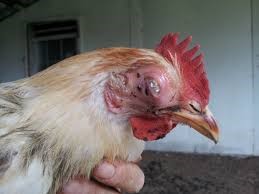 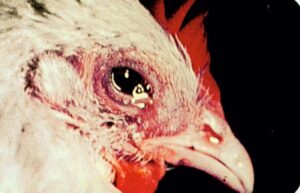 |
Symptoms:
- Swelling of head and eyes.
• Difficulty in respiration.
• Coughing.
• Mainly seen in broilers in summer season.Treatment:
- Tylosin 50%- 1g for 100 birds.
• Regular vaccination of broilers.
• Keeping the environment ammonia free.Fowl Pox
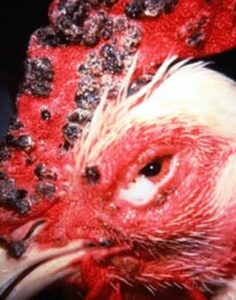 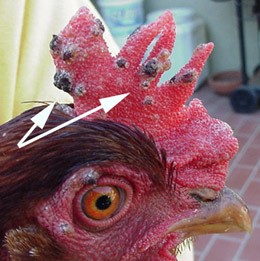 |
Symptoms:
- Low mortality.
• Lack of flock vigour and weight loss.
• A mild to moderate loss in egg production.
• Scabby lesions on the head, neck and unfeathered parts of the skin.Treatment: • Treatment is not effective. Only vaccination.
Gumboro Disease Of Infectious Bursal Disease
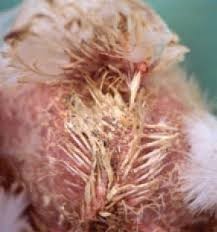 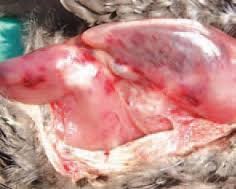 |
Symptoms:
- High fever with severing
• Depression
• Sticky droppings
• DeathTreatment:
- Treatment is not very effective. Homoeopathy drugs may be helpful.
• The birds should not be disturbed.
• Regular vaccination is necessary.Infectious Bronchitis
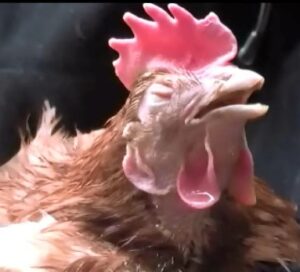 |
Symptoms:
- Indifference and depression.
• Sneezing, gasping and coughing.
• Nasal discharge.
• Abnormal respiratory sounds (rales).
• Weakness and huddling near the light source • Reduced egg production in laying birds. Low egg quality and soft egg shells are noted.
• Mortality due to kidney disease caused by the nephrotropic strain of the IB virus.
• Inflammation of the air sacs may be a complication of IB.Treatment:
- Treatment is not much effective. Only symptomatic treatment.
• Preventive vaccination is the only measure to control this disease.Newcastle Disease
- Newcastle disease is probably the most important disease for poultry farmers around the world. This is a production disease that causes a large number of deaths in chickens and huge losses to farmers and the industry.
• Because there is no treatment and the disease spreads so quickly, sick chickens should be slaughtered immediately.
• This disease is caused by a virus.
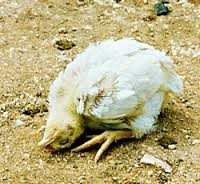 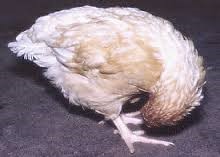 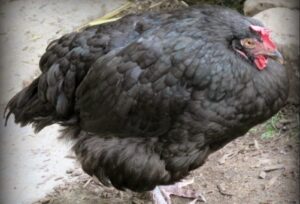 |
Signs in sick chickens:
A large number of chickens will die suddenly without any of the following apparent causes:
o Depression
o Nervous signs (seating in the posture of Penguin)
o Sneezing, swollen eyes, difficulty in breathing
o Greenish Diarrhoea
o Death
Treatment
- There is NO treatment for the disease and all the chickens may die within a few days. Very few chickens survive.
• It is best to prevent the diseases by good management and a vaccination programme.
• Your animal health technician or veterinarian will give you the best advice in a Newcastle disease outbreak, especially as this is a controlled disease.Prevention
- You should vaccinate all the chickens against this disease by using a good vaccination programme before any signs appear.
• It is a very contagious disease, which means it spreads easily to other farms. You should not visit your neighbours without washing and putting on new clothes and shoes. You should also recommend that your neighbours vaccinate their chickens as soon as possible.
• You should clean the chicken house thoroughly with soap and water. All equipment must be washed. Everything should then be disinfected. You should also wash and disinfect your clothes and shoes. All chicken litter or dead chickens should be burned to prevent the spread of the disease.Marek’s Disease
Symptoms:
- Mainly seen in Broilers.
• Paralysis of two wings and legs due to peripheral nerve involvement. The nerves are 2–3 times their normal size.
• Acute Marek’s disease occurs mainly in 6–12 weeks old birds. It is manifested with tumours in the liver, spleen, kidneys, brain, spinal cord and dorsal root ganglia and with sudden death. The heart, lungs, gonads and muscles may also be involved.
• Transient paralysis in 12–18 weeks old pullets become paralysed and may recover with 24 hours if moved to a quiet place.
• Watery diarrhea.Treatment: No efficient treatment.
Prevention: Vaccination on 0th day is the only measure to control the disease.
Deficiency Diseases
- Thiamin Deficiency (Vitamin B1)
The chickens acquire a specific posture with flexed legs and the head drawn back (stargazing).
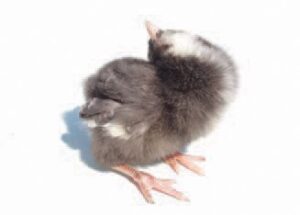 |
| Star Gazing Appearance |
Treatment: Supplementation of Multivitamins.
- Riboflavin Deficiency (Vitamin B2)
The typical clinical sign are curled toes due to paralysis. In the beginning, the toes are slightly flexed and chickens tend to stand on their hocks. In moderate cases, a marked leg weakness and toe flexion in a different extent are observed. In severe cases, the toes are completely curled downward and inward and complete weakness of legs is present. A considerable improvement and relief could be expected if the treatment with water soluble vitamins is initiated in the initial stage of the disease.
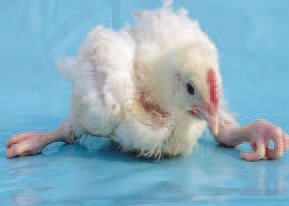 |
| Curled Toe Paralysis |
- Vitamin E or Selenium Deficiency (Muscular dystrophy)
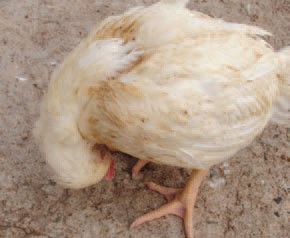 |
Symptoms:ataxia, disequilibrium, falling on the back, frequent movements with the wings, strongly stretched legs (clonic spasms) and twisting of the head. Treatment:Supplementation of Multivitamins & Multi minerals.


